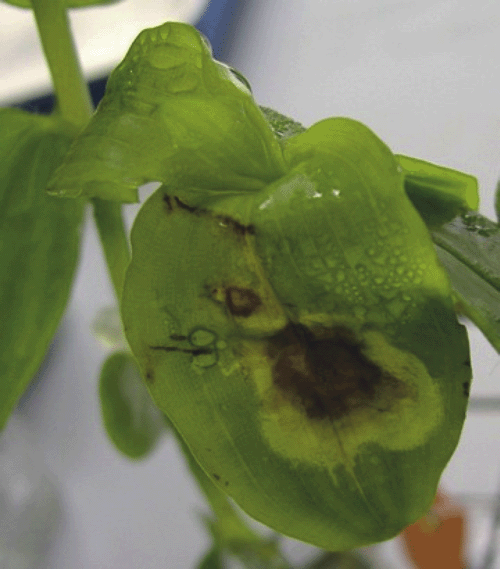Isolation of white rot, Sclerotinia sclerotiorum, causing leaf necrosis on Tradescantia fluminensis in New Zealand
N. W. WaiparaLandcare Research, 231 Morrin Road, University of Auckland, Tamaki Campus, Private Bag 92170, Auckland, New Zealand. Email: waiparan@landcareresearch.co.nz
Australasian Plant Disease Notes 1(1) 27-28 https://doi.org/10.1071/DN06012
Accepted: 27 September 2006 Published: 6 October 2006
Abstract
Sclerotinia sclerotiorum is reported from diseased plants of Tradescantia fluminensis. The fungus was isolated from necrotic leaf lesions on observed plants that were infesting parkland near Auckland, New Zealand. Subsequent reinoculation of S. sclerotiorum onto leaf and stem tissue satisfied Koch’s postulates that T. fluminensis is a host of this isolate.
Tradescantia fluminensis Vell. (Commelinaceae), known as wandering jew and now commonly referred to by its genus name alone, is a ground-smothering perennial herb native to South America. In 1910, it was introduced to New Zealand by a Manawatu farmer as a ground cover plant to prevent soil erosion. By 1916, it had rapidly naturalised and is now a common invader across all frost-free regions in New Zealand (Standish et al. 2001). Because it is a serious problem in native forest where its dense ground cover prevents native plant regeneration (Standish et al. 2001), and because it also has deleterious impacts on invertebrate biodiversity, litter decomposition and nutrient availability in native soils (Standish et al. 2004), it has been listed as a significant plant pest by the New Zealand Department of Conservation.
Sclerotinia sclerotiorum (Lib.) de Bary, commonly known as white rot, is a naturally occurring widespread pathogen of many unrelated plant hosts in New Zealand (Pennycook 1989). As well as being a serious pre- and post-harvest pathogen of significant economic crop species (Pennycook 1989), it has previously been recorded on several weed species in New Zealand (Waipara et al. 1993) and has subsequently been developed as an inundative mycoherbicide for weed biocontrol purposes (Waipara et al. 2006).
In September 2004, leaf disease symptoms were observed on a patch of Tradescantia plants invading reserve parkland in Auckland. Symptoms exhibited were watery brown, irregular-shaped necrotic lesions (Fig. 1), which are typical of Sclerotinia white rot recorded on other hosts (Waipara et al. 1993). The spring conditions in the Auckland region of high humidity and leaf wetness were ideal for infection by S. sclerotiorum. An extensive disease survey of Tradescantia infestations across New Zealand during 2002–03 did not recover S. sclerotiorum. In fact, this survey showed the plant to be relatively free of primary pathogens unless associated with environmental light or drought stress (N. W. Waipara, unpublished data). Therefore even a moderate level of disease on the plant, while growing in ideal conditions, was regarded as peculiar.

|
Two plant samples with leaves exhibiting necrotic lesions were collected and cultural methods were used to isolate the pathogen. Tissue fragments (2–5 mm) from the leading edge of the lesion were excised with a sterile scalpel, surface sterilised with a solution of sodium hypochlorite (1% a.i.), and plated onto potato dextrose agar (PDA, Difco Laboratories) amended with antibiotic (0.02% streptomycin, Sigma, St Louis, MO). The microcolonies that emerged on the PDA plates were subcultured and identified, based on morphological characters, as S. sclerotiorum.
A pathogenicity assay to confirm Koch’s postulates was then undertaken. Twelve Tradescantia plants, each comprising a single stem with 10 leaf nodes, were grown hydroponically in glass tubes for 5 days until primary roots had begun to sprout. Fungal plugs (5 mm diam.) of S. sclerotiorum, incubated at 22°C on PDA for 7 days, were inoculated onto 5 leaves and 5 nodes. Twelve control plants were inoculated with fungus-free PDA plugs. Plants were maintained at room temperature under high humidity for 21 days. Necrotic leaf and stem lesions had mostly appeared on all inoculated plants after 7 days confirming pathogenicity of the fungus on this host. Further inoculation assays were subsequently undertaken to further elucidate the pathogenicity of S. sclerotiorum on T. fluminensis in New Zealand (Waipara et al. 2006). Reisolation of the fungus from necrotic leaf and stem lesions, post inoculation, confirmed Koch’s postulates.
A reference culture of S. sclerotiorum from T. fluminensis has been deposited in the International Collection of Microorganisms from Plants, Landcare Research, Auckland, New Zealand.
Standish RJ,
Robertson AW, Williams PA
(2001) The impact of an invasive weed Tradescantia fluminensis on native forest regeneration. Journal of Applied Ecology 38, 1253–1263.
| Crossref | GoogleScholarGoogle Scholar |

Standish RJ,
Williams PA,
Robertson AW,
Scott NA, Hedderley DI
(2004) Invasion by a perennial herb increases decomposition rate and alters nutrient availability in warm temperate lowland forest remnants. Biological Invasions 6, 71–81.
| Crossref | GoogleScholarGoogle Scholar |

Waipara NW,
Bourdôt GW, Hurrell GA
(2006) Sclerotinia sclerotiorum shows potential for controlling water lettuce, alligator weed and wandering jew. New Zealand Plant Protection 59, 23–27.



